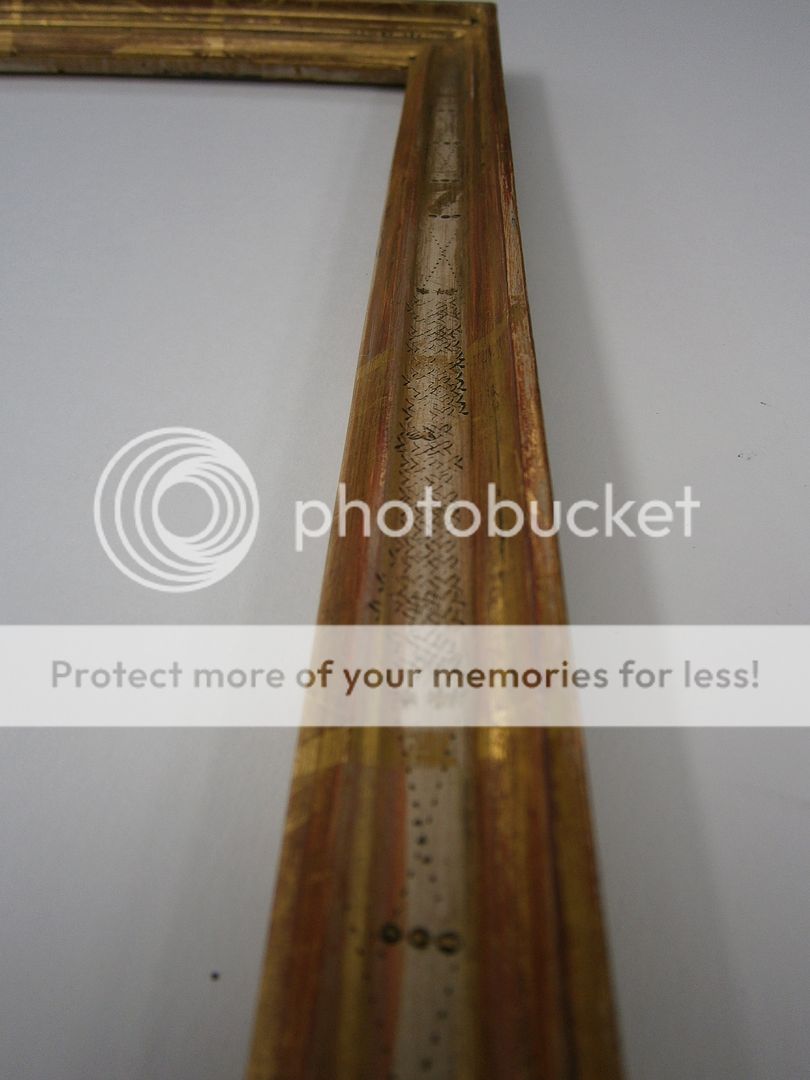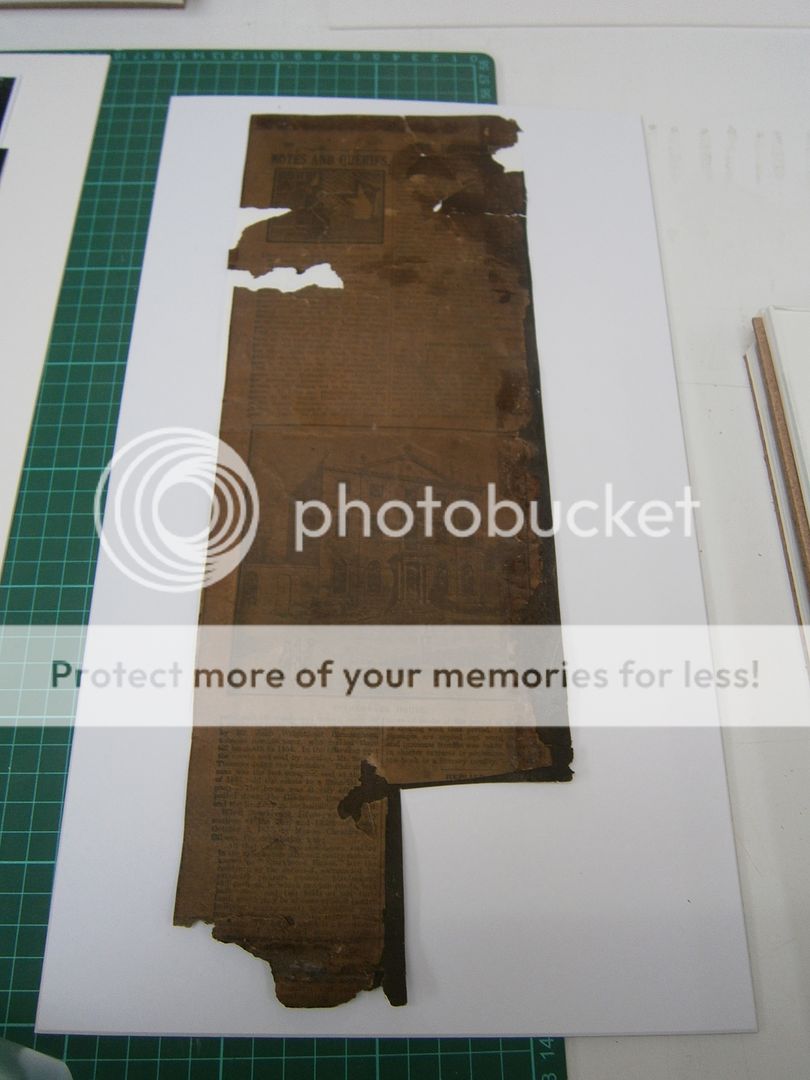This little frame is easily my favourite frame for a while. I like everything about it, the profile, the distressing to the water gilding revealing the bole and gesso, and the punched decoration in the centre panel is really lovely. It was probably made in the early to mid 20th Century.
Friday
Re-using old mounts
Sometimes it is necessary to re-use old or antique mounts. This old mount with lines needs to be used again, so a new mount will be cut using Bainbridge Alphamat Artcare mountboard, the borders will be cut a couple of mm narrower all round and will go under the old mount. I will post more on the Alphamat Artcare boards in the near future, but more details on them can be seen here:
Zeolites and Artcare Technology
These mountboards contain molecular traps which actively absorb and neutralize harmful gasses given off as paper and boards degrade.
I think in this case, where it is the customers wish to keep the old mount, then the use of this type of mountboard is the best solution.
Zeolites and Artcare Technology
These mountboards contain molecular traps which actively absorb and neutralize harmful gasses given off as paper and boards degrade.
I think in this case, where it is the customers wish to keep the old mount, then the use of this type of mountboard is the best solution.
Stripping
Painting stripping later applied bronze paint from a 19th Century watercolour frame, so it can be regilded in a more original way. It has a few missing sections of ornament which will be replaced, then the frame will be painted with bole and gilded.
Labels:
antique frame,
compo,
repair,
restoration
Reproduction 18th Century frame
Here a reproduction 18th Century English Carlo Maratta type profile has been used to frame an antique painting on canvas.
Labels:
carlo maratta,
reproduction
Lely frame
An English style of frame that is often called a Lely frame or panel frame, named after the artist Sir Peter Lely and the distinct plain panels between the carved details. It originated in the 17th Century, and was inspired by Louis XIII frames. This is a composition version that is probably from the 19th Century. It has been overpainted, but is still a nice looking antique frame.
Labels:
antique frame,
Louis XIII,
panel frame
Thursday
Wednesday
Large and Oversize Frames
Perhaps only 1 in 5 quoted goes ahead, people seem to think that material prices go up proportionally with size, but in reality the choice of certain oversize materials is limited and the costs considerably higher than the stock or standard sizes of 32" x 44" (some suppliers standard size is 32" x 40" and 32" x 47") and the jumbo size of 44" x 64" (some jumbo boards are 40" x 60"). Other factors that need to be considered are the extra labour involved, the equipment needed, and workshop space required to handle the assembly and fitting of large frames. The images below are just to give an idea of some methods that can be used.
There are some other methods that don't use a mount, for example a wide flat wooden slip that has a bevel edge can be used to replicate a mount, this can be painted or gessoed and lined with mountboard, so that the artwork is not in direct contact with the wood. An aperture could even be cut out of a sheet of MDF which can then be painted. Another option is that the artwork, print, or poster can be float mounted on to a backing, with a spacer to keep it away from the glazing.

Sheets of Foamboard, Correx, Gatorfoam, Kapa, and Tycore board can be used for backing and support, these are rigid, pH neutral, and lightweight. These types of board are all preferable to MDF or plywood which are heavy, prone to bowing, and contain impurities which can be harmful to art. MDF can be used but it is better to also use cross braces to make the backing more rigid.
For the glazing, acrylic in 4mm to 6mm offers the most practical solution for large sizes, it is lighter than glass and virtually unbreakable. Laminated glass can also be used but it is very heavy. Both acrylic and laminated glazings are available with anti-reflective and UV filter properties, these are known as 'museum glazing', and are used for the highest specification framing projects.
The frame itself of course needs to be suitable regarding strength, width, and depth, although even relatively narrow frames can be used if required when combined with a sub-frame, using pocket hole screws to secure the sub-frame to the frame. This example shows a bevel cleat which can be used to hang the frame to a matching section of timber fixed to the wall.

Where cost is an issue and conservation is not then large posters can be framed directly against the acrylic glazing, as acrylic is much less prone to developing condensation on the inside of the glazing when compared to glass.
Labels:
large frame,
oversize,
spliced,
spliced mount
Sunday
Floated panel
An easy and effective way of float mounting the thin panels that some artists paint on. The 3M Velcro on the back of the panel is fixed with a small amount of Evacon R adhesive. On thicker panels like 6mm MDF this can be backed up with 3mm staples. The Velcro holds the panel in place but it can be easily removed with minimum damage or alteration to the panel. It is useful if artists want to be able to swap over paintings. For heavier or larger panels, or more critical applications 3M also make a product called Dual Lock which is a high performance reclosable fastener.
Labels:
float frame,
float mounted
Saturday
Major (beyond) repair work
This 19th Century composition ornamented frame was close to being beyond repair, with major damage on the bottom section, and lots of other missing areas on the other three sides. The gilded and painted glass (Verre églomisé) was also damaged and this was carefully touched up by another gilded who worked with us sometime ago. It has taken a long time to finish, but I think the end result is worth the labour, as it's a good compo frame with a nice pattern on the cove.
Labels:
compo,
repair,
restoration
Florentine frame
This lovely carved wood Italian frame, often called a Florentine frame, has come in for some repairs and a good tidy-up. They are clearly very prone to damage with all those scrolls and protruding leaf tips. This one is probably 19th Century. You also see them made from composition or plaster (instead of carved from wood) these versions are a nightmare to repair, the scrolls are supported on wire and as the compo cracks over time they just start falling apart.
Labels:
antique carved frame,
florentine,
Italy
Finished gilded and painted frames
The top photo shows some colourwash being applied with a brush it is diluted emulsion paint from Farrow and Ball, the next photo shows the two frames after all the colourwashes have been put on the scoop. The last photo shows one of the finished frames, I was particularly happy with the end result of this frame, it was exactly what I had originally envisaged the finish would look like.
Labels:
cove,
painted,
water gilded
Barbizon repairs
This 19th Century compo Barbizon frame had lots of missing pieces of ornament and gesso, and badly gaping mitres. At first glance you notice the obvious areas where the white gesso is visible, but the broken areas of compo can be harder to spot as compo can look similar in colour to dirty/old gilding.
Labels:
antique frame,
Barbizon,
Louis XIII,
Louis XIV,
repair
Friday
Gilded bole
The two frames from a couple of posts ago, which were painted in Georgian Red bole. They have been gilded, distressed, and then the outers are lightly burnished. The next photo shows the gilding masked off and it the cove has been painted with an acrylic primer and then two coats of off-white.
Labels:
burnished,
painted,
water gilded
Mount decoration
These mounts are often called washline mounts (or mats), French mounts, or English line and wash mounts. The examples here have both been done by framers in London. I like the deep blue wash used on the one, and the second has two wash colours combined with thin lines and the inner edge of the top mount is the original mountboard colour; giving three subtle colour shades to the mount. I think these types of mounts can look great on more traditional artwork, and even some more contemporary designs can be used to good effect on more modern work.
Thursday
Ornate frames
A couple of examples of modern made ornate frames, the top one is made from composition, while the second frame is carved wood and is from (perhaps obviously due to the design) the Far East.












